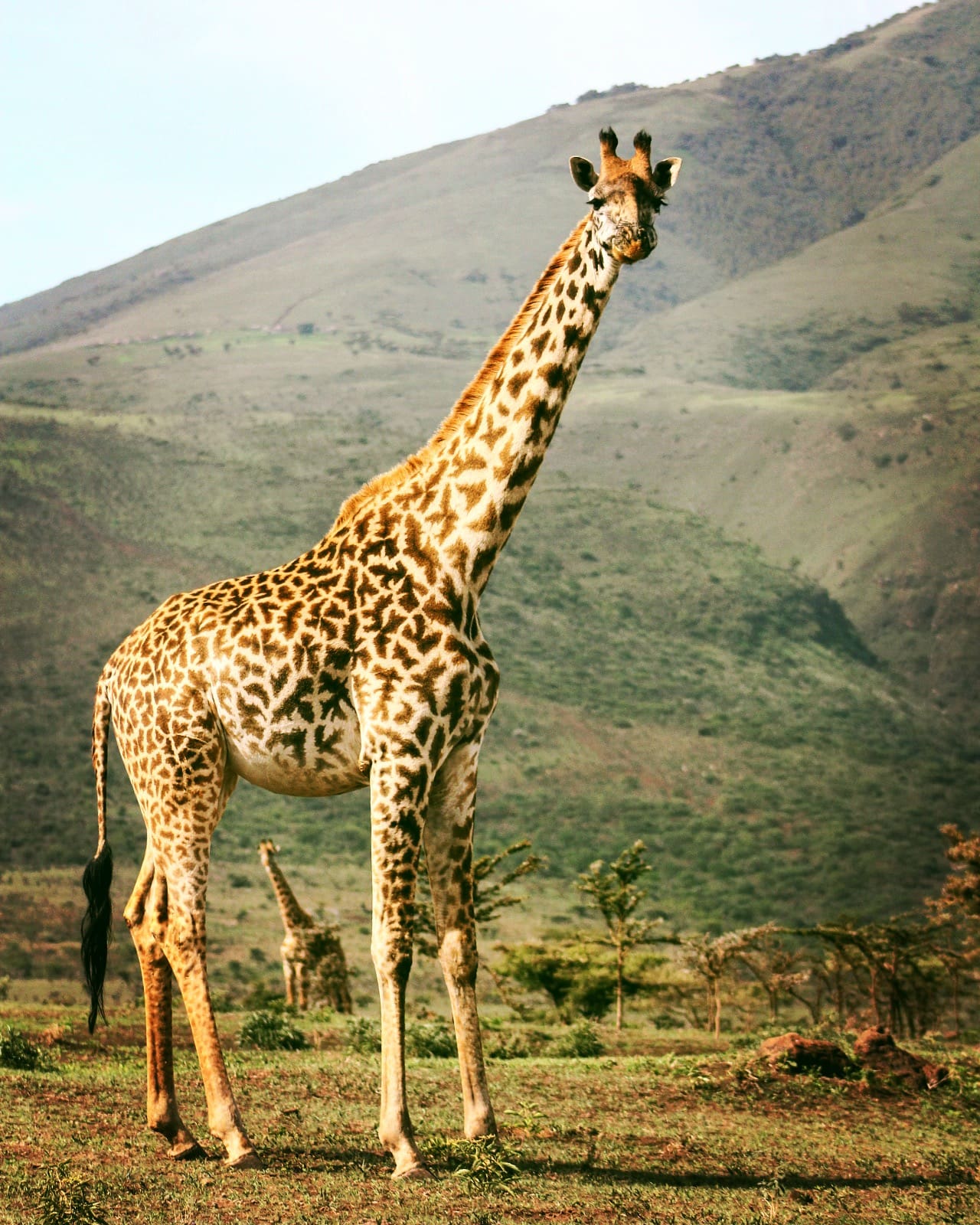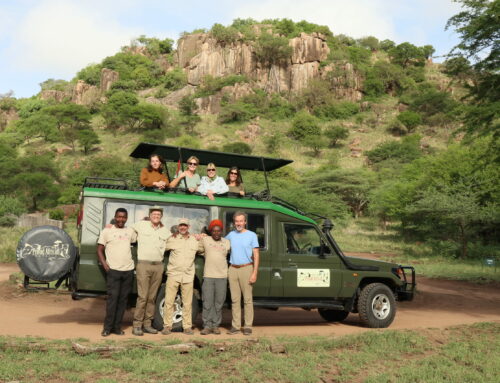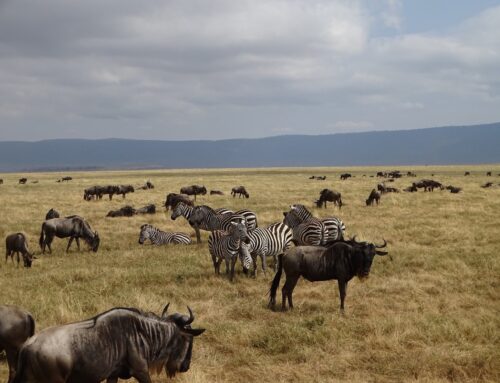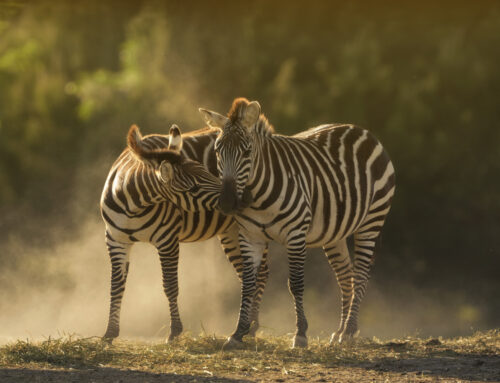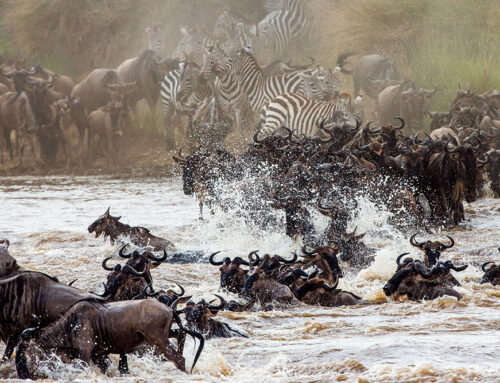July 21st was the longest day of the year, which only makes sense to celebrate the tallest and longest animal, the giraffe! Adventure through Tanzania and you are bound to spot the Masai Giraffe, also known as Tanzania’s national animal. Their distinctive, irregular, jagged, star-like blotches, extending down to their hooves are unique to each giraffe and will leave you awe struck of this long legged beauty.
The giraffe’s extraordinary height, with long necks and legs, standing about 14-19 feet tall, allow them to reach to tip of the trees for the most desired greens. Giraffes’ long tongue, up to 20 inches, allow them to strip leaves off tree branches, which most other animals cannot reach. Additionally, many trees, such as acacia trees encompass sharp thorns to warn off predators, however, Giraffes are virtually unaffected by the pricks due to their long, leathery, and dexterous tongue. The dark coloring of their tongue protects them from sun exposure.
Though giraffes spend the majority of their day eating, and can consume up 75 pounds of food per day, they can go weeks without water, a contributing factor to their protective instinct, since watering holes typically expose giraffes in the wild, and can put them in danger of predators. If a giraffe does happen to come face to face with, a lion, or other predator, they will most likely sprint from the attack, rather than put up a fight. They can run up to 35 mile per hour, which is over 10 mph faster speed than the fastest man alive, Usain Bolt. When the fight or flight instinct kicks in and flight is not an option, do not underestimate the giraffes’ ability to fight. A quick kick from one of their long legs can do serious damage, or even kill an unlucky lion. Just think about that impact into the head or heart!
Giraffes’ height, advantageous to filling their stomach with supreme salad, and make them an easy for safari goers to spot, yet in terms of safety and concealment, they are easily exposed to both tourist and predators alike. Giraffes are limited to the savannah, which is in African grassland, or in light woodland. They do not bother to hide behind the thick forest and trees, because this would make it harder to view an approaching lion. Giraffes keep their friends close, and their enemies at an eyes distance away.
Giraffes are listed as Vulnerable to extinction on the IUCN Red List of Threatened Species. Giraffe numbers in Africa have plummeted by a staggering 40% over the last 30 years. Estimates today report that there are fewer than 100,000 giraffe remaining in all of Africa.
You can support these important, innovative and unique giraffe conservation efforts by helping to raise much-needed funds. Follow the link below for more information regarding giraffe conservation.
July 21st was the longest day of the year, which only makes sense to celebrate the tallest and longest animal, the giraffe! Adventure through Tanzania and you are bound to spot the Masai Giraffe, also known as Tanzania’s national animal. Their distinctive, irregular, jagged, star-like blotches, extending down to their hooves are unique to each giraffe and will leave you awe struck of this long legged beauty.
The giraffe’s extraordinary height, with long necks and legs, standing about 14-19 feet tall, allow them to reach to tip of the trees for the most desired greens. Giraffes’ long tongue, up to 20 inches, allow them to strip leaves off tree branches, which most other animals cannot reach. Additionally, many trees, such as acacia trees encompass sharp thorns to warn off predators, however, Giraffes are virtually unaffected by the pricks due to their long, leathery, and dexterous tongue. The dark coloring of their tongue protects them from sun exposure.
Though giraffes spend the majority of their day eating, and can consume up 75 pounds of food per day, they can go weeks without water, a contributing factor to their protective instinct, since watering holes typically expose giraffes in the wild, and can put them in danger of predators. If a giraffe does happen to come face to face with, a lion, or other predator, they will most likely sprint from the attack, rather than put up a fight. They can run up to 35 mile per hour, which is over 10 mph faster speed than the fastest man alive, Usain Bolt. When the fight or flight instinct kicks in and flight is not an option, do not underestimate the giraffes’ ability to fight. A quick kick from one of their long legs can do serious damage, or even kill an unlucky lion. Just think about that impact into the head or heart!
Giraffes’ height, advantageous to filling their stomach with supreme salad, and make them an easy for safari goers to spot, yet in terms of safety and concealment, they are easily exposed to both tourist and predators alike. Giraffes are limited to the savannah, which is in African grassland, or in light woodland. They do not bother to hide behind the thick forest and trees, because this would make it harder to view an approaching lion. Giraffes keep their friends close, and their enemies at an eyes distance away.
Giraffes are listed as Vulnerable to extinction on the IUCN Red List of Threatened Species. Giraffe numbers in Africa have plummeted by a staggering 40% over the last 30 years. Estimates today report that there are fewer than 100,000 giraffe remaining in all of Africa.
You can support these important, innovative and unique giraffe conservation efforts by helping to raise much-needed funds. Follow the link below for more information regarding giraffe conservation.

